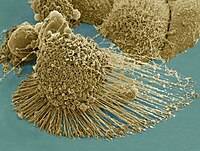
Photo from wikipedia
The aim of this study was to evaluate the performance of a pen-type laser fluorescence (LF) device (LFpen: DIAGNOdent pen) to detect and monitor the progression of caries-like lesions on… Click to show full abstract
The aim of this study was to evaluate the performance of a pen-type laser fluorescence (LF) device (LFpen: DIAGNOdent pen) to detect and monitor the progression of caries-like lesions on smooth surfaces. Fifty-two bovine enamel blocks were submitted to three different demineralisation cycles for caries-like lesion induction using Streptococcus mutans, Lactobacillus casei and Actinomyces naeslundii. At baseline and after each cycle, the enamel blocks were analysed under Knoop surface micro-hardness (SMH) and an LFpen. One enamel block after each cycle was randomly chosen for Raman spectroscopy analysis. Cross-sectional micro-hardness (CSMH) was performed at different depths (20, 40, 60, 80 and 100 μm) in 26 enamel blocks after the second cycle and 26 enamel blocks after the third cycle. Average values of SMH (± standard deviation (SD)) were 319.3 (± 21.5), 80.5 (± 31.9), 39.8 (± 12.7), and 29.77 (± 10.34) at baseline and after the first, second and third cycles, respectively. Statistical significant difference was found among all periods (p < 0.01). The LFpen values were 4.3 (± 1.5), 7.5 (± 9.4), 7.1 (± 7.1) and 5.10 (± 3.58) at baseline and after the first, second, and third cycles, respectively, among all periods (p < 0.05). The CSMH values after the second and third cycles at 20, 40, 60, 80 and 100 μm were 182.8 (± 69.8), 226.1 (± 79.6), 247.20 (± 69.36), 262.35 (± 66.36) and 268.45 (± 65.49), and for the third cycle were 193.7 (± 73.4), 239.5 (± 81.5), 262.64 (± 82.46), 287.10 (± 78.44) and 284.79 (± 72.63) (n = 24 and 23), respectively. No correlation was observed between the LFpen and SMH values (p > 0.05). One sample of each cycle was characterised through Raman spectroscopy analysis. It can be concluded that LF was effective in detecting the first demineralisation on enamel; however, the method did not show any effect in monitoring lesion progression after three cycles of in vitro demineralisation.
Journal Title: Lasers in Medical Science
Year Published: 2017
Link to full text (if available)
Share on Social Media: Sign Up to like & get
recommendations!